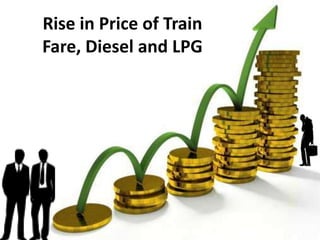
Rise in Price of Train Fare, Diesel and LPG
- 1. Rise in Price of Train Fare, Diesel and LPG
- 2. 'Rail fare hike to hit the common man' • The price of train tickets had not been increased for a decade said Railways minister Pawan Kumar Bansal. He further said that there will be no increase in the Railways Budget this year. • Railway had incurred a loss of Rs 22,000 crore in the passenger segment in 2012, an increase of deficit of Rs 4000 crore from the last year. • The shortage of funds has forced railways to curtail allocations for majority of projects. • The minister said that the hike was "imperative" to maintain and improve the safety measures and cleanliness of the trains as well as upgrade railway stations.
- 4. ‘Train fare hike a stab in the back’ • A few months ago, the railways started levying service tax on tickets of AC class. • The increase ranges from 2 paise per km for Second Class Ordinary (suburban) to 10 paise per km for AC First Class. • The hike in Sleeper Class: 6 paise while in AC Chair Car: 10 paise. AC 3-Tier hike is 10 paise. First Class increase is 03 paise. AC 2-Tier has gone up 06 paise and AC First Class by 10 paise. • Passenger fares hiked across the board for the first time in 10 years with effect from midnight of 21 Jan 2012.
- 7. Brace for higher fuel bills • Diesel is the main fuel for transportation and farming sectors • Any increase in the fuel's price has a cascading effect on the cost of daily living. • For diesel, the options are to raise the price by Rs 1.50 per litre plus taxes every month between January and March. Thereafter, it could be raised by Re 1 plus taxes every month till its pump price equals market rate. The alternative, or a politically more workable proposal, suggests raising the price by 60 paise per litre every month till the gap between subsidized and market prices are wiped out.
- 8. DIESEL PRICE HIKE Old New States Price Price New Delhi 41.32 47.15 Mumbai 46.25 53.14 Kolkata 44.76 50.98 Chennai 43.91 50.13 From http://www.mypetrolprice.com
- 9. Diesel price on the rise • A sharp rise in its price can shock the economy and stoke public anger. • That's why the government may opt for the soft option of a partial float by setting a fixed subsidy say Rs 5 a litre. Under this system, the fuel's pump price would be raised if the market rate rises beyond the fixed subsidy.
- 10. Hike in price of non- subsidised cooking gas • Cooking Gas have direct relation to the last household of the country. Thus any increase in the price of this commodities directly affects the life of ordinary people. • Cooking gas directly raise the price of meal resulting in more problems for the society already grappling with price rise and poverty. • Cooking gas price rise also hamper Government’s plan to promote the use of clean fuels for cooking in rural areas since people would not prefer costly cooking gas to other cheaper domestic alternatives (i.e. woods and uplas).
- 11. Subsidised Prices in Non - Subsidised Prices in States Metros (Rs./14.2 kg Metros (Rs./14.2 kg cylinder) cylinder) Delhi 410.50 895.50 Kolkata 412.50 925.00 Mumbai 435.00 906.50 Chennai 398.00 890.00
- 12. You continue performing the rituals while I cook food for Saving gas one time….
- 13. Some Relief to the people • The government is likely to raise the cap on subsidised cooking gas for households to nine from six cylinders per year, Petroleum Minister M. Veerappa Moily. • Government has introduced LPG portability for cooking gas. With this customers will be able to change cooking gas sellers and dealers online and switch from one distributor or company from a click of a button. • This has been done to provide customers, greater choice to select their distributor and also bring competition amongst the distributors. LPG portability is being launched as a pilot in Chandigarh from today. • It will be expanded to 25 more districts in 2013-1.
- 14. How it is affecting the business ? For every Business to function/operate, there are certain inputs (workers, staff, material, etc) which a business needs to bear. • With increase in the prices of basic goods (transportation, gas, oil, etc) the business has to incur huge expenses as the employees will demand more money and they also have to spend more to get there inputs (raw-material, machine, etc). • With the increase in salaries and inputs the business will get an output. Since the cost price is more the business will want to increase there price as they would want to keep the current profit rate. Thus there is a problem….
- 15. Solutions Effect Results Have a mass job cut It will reduce the cost price • Dissatisfaction among workers to some extent. • May result in decrease in output Reduce the profit % It would make the • Dissatisfaction among employees happy investor/shareholder • May stop investing in the company Increase the price It would make the • Consumer might not want to employees and spend more as there expenses shareholders happy have also increased • Consumer might find it very expensive. Thus, Sales might fall, resulting in lesser profit
- 16. Recommendations • As per the survey conducted most people suggested that a huge amount should be spend on improving the infrastructure, better utilization of resources which might help in bringing down the price of producing that product or providing that services. But there are limitations also… Does the company have sufficient fund to make that change. Will all the members agree to that proposal. Even after spending, will it bring in desired profit.
- 17. THANK YOU